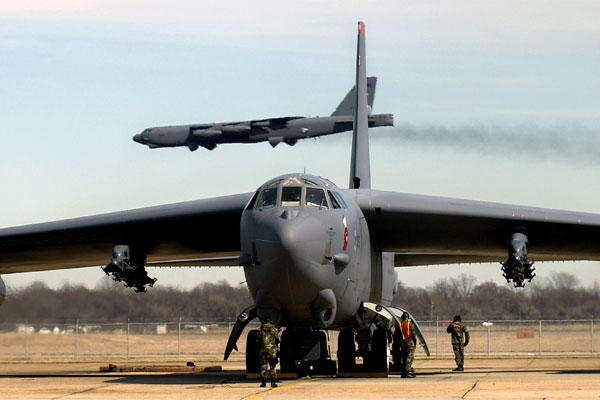During the opening three days of the Mosul offensive, U.S.-led airstrikes rattled the city at a rate of one bomb every eight minutes, an official said.
The sheer volume of strikes sets the operation apart from others in the ongoing campaign against militants affiliated with the Islamic State of Iraq and Syria, or ISIS, according to Col. Daniel Manning, the deputy director of the Combined Air Operations Center.
"It's a pretty intense bombing campaign if you think about each of these bombs are precision-guided weapons … so it's a really high rate to be concentrated over one city over a prolonged period of time," Manning told Military.com in a telephone interview Friday.
Since Iraqi Prime Minister Haider al-Abadi's Oct. 16 declaration of the beginning of the assault to recapture Mosul, whose population has dwindled to about 665,000 residents, the air coalition conducted more than 191 strikes through Nov. 1, employing over 1,352 weapons for operations, according to Air Forces Central Command spokeswoman Kiley Dougherty.
From the start of Operation Inherent Resolve in 2014, Dougherty said the coalition has struck Mosul with 1,239 targets, dropping 5,941 bombs.
"You tend to employ more weapons when the weather is better, and when you're partner forces are on the move because when they're on the move, they're finding the enemy, forcing the enemy to reveal themselves, and we're there to strike them," Manning said.
"We can certainly employ weapons in all weather -- we have sensors that can look through the weather -- but [a storm] usually slows down an operation of this size," he added.
Mosul has been a months-in-the-making operation, Manning said. And planning out the airspace for Air Force and coalition aircraft has been essential to "work the stack" of aircraft operating in a vast city but tight airspace.
Aircraft from drones to fighters to bombers "are given different altitude restrictions, from low to very high where you're assigned a certain block of altitude at the flight of two aircraft, and you maintain that block knowing that there are aircraft below and above you," Manning said.
The same goes laterally. If there is an artillery strike from below that has the ability to fire high enough where "it can reach aircraft, you have to stay East or West of a certain line," he said.
A coveted aircraft during the operation has been the B-52 long-range bomber. The Stratofortresses have the ability to stay airborne for a longer duration, have capable sensors to identify targets, and carry a wide-variety of bombs "attacking everything from vehicles to large-site targets."
"Frankly, we want our partners and the enemy to see the airpower [the B-52] has overhead," Manning said. "A B-52 encourages our partner force that we have their back. Being seen is actually a pretty good thing."
In April, several B-52s arrived at Al Udeid Air Base, Qatar, to join the American-led campaign in place of the B-1B Lancer. The aircraft stepped up lucrative targeting throughout May and June, more than doubling their strikes against weapons caches, then-AFCENT spokesman Lt. Col. Chris Karns told Air Force Times in June.
The tactics ISIS have been using to try and thwart the coalition in Mosul aren't revolutionary but they've complicated the dynamic throughout the city, Manning said. The group has burned oil trenches to throw off intelligence, surveillance and reconnaissance (ISR) aircraft; set off vehicle-borne improvised explosive devices; attempted hostage takeovers; and used snipers to kill coalition forces.
RELATED: Raqqa Offensive Should Wait for Fall of Mosul: Turkey
That's why ISR aircraft -- most heavily used throughout the Middle East theater -- are a must-have to predict ISIS' next move while detecting the location of civilians.
In May, Lt. Gen. Charles Brown, now the deputy commander of U.S. Central Command, noted the use of ISR almost always translates into a more clean-cut mission.
"I would actually like to have more ISR and really be able to use it," he said at the time, "Because what it helps me to do is develop targets [and] ... strike at the same time as we develop those targets. The more ISR I have, I can minimize the risk to civilian casualties and continue the precision air campaign that we have."
"It's also very likely when ISR aircraft go out over Mosul, they will employ one if not all of the weapons that they have," Manning said.
For example, MQ-1 Predators and MQ-9 Reaper drones account for 15.6 percent of strikes in OIR, ACC spokesman Benjamin Newell told Military.com last month. They also account for 8.6 percent of all Combined Forces Air Component weapons dropped in OIR. "They are involved in nearly every operation in OIR, in one capacity or another," Newell said.
"This is a very, very difficult way to fight," Manning said. "And we can't say when it's going to be over."
-- Oriana Pawlyk can be reached at oriana.pawlyk@military.com. Follow her on Twitter at @Oriana0214.
Related Video:






















